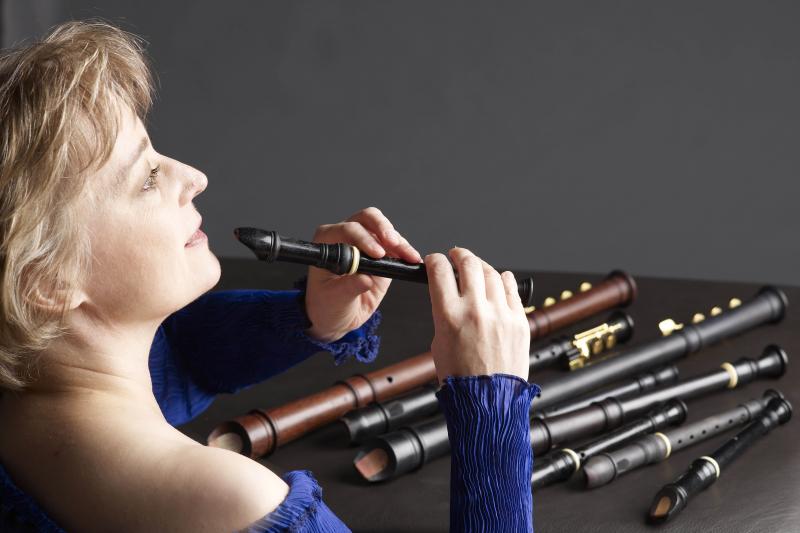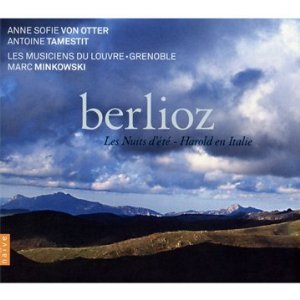Classical CDs Weekly: Bach, Berlioz, Michala Petri | reviews, news & interviews
Classical CDs Weekly: Bach, Berlioz, Michala Petri
Classical CDs Weekly: Bach, Berlioz, Michala Petri
Funereal Bach, Byronic Berlioz and a Danish fairytale for choir and recorder

 Bach: Trauer-Music: Music to Mourn Prince Leopold Taverner Consort and Players/Parrott (Avie)
Bach: Trauer-Music: Music to Mourn Prince Leopold Taverner Consort and Players/Parrott (Avie)
Prince Leopold was Bach’s patron in the small town of Cöthen, where the young composer arrived to take up the post of Capellmeister in 1717. Leopold was a cultured and genial employer, who, according to Bach, “both knew and loved music”. And though the composer only stayed until 1723, his Cöthen years were creatively productive. Much of Bach’s music from this period has been sadly lost, including the sequence of pieces written in 1728 to mourn Leopold’s sudden death at the age of 34. A libretto, by Bach’s colleague Christian Henrici, survives. This has enabled academics convincingly to argue the case for a reconstruction, using movements from the St Matthew Passion and the recently completed Trauer-Ode for the Electress of Saxony. Bach often recycled his own works, and it’s possible that the suddenness of the funeral commission prompted such a practical solution.
The booklet reveals where individual arias and choruses have come from, and the finishing touches are provided by conductor Andrew Parrott’s newly composed recitatives. The use of one voice per part never sounds anaemic and the singers’ crystalline clarity is a joy to the ears – little surprise when you reflect that Parrott recorded one of the best small-scale versions of the B Minor Mass in the 1980s. What’s most important is that the work sounds like a real, finished work, not a speculative completion. It’s beautifully recorded with good notes.

Part symphony, part extended viola concerto, Berlioz’s Byron-inspired Harold en Italie appears here on period instruments. The work was commissioned by Paganini, who was initially unimpressed by a solo part which he considered insufficiently flashy and contained too many bars rest. And perhaps he was on to something; the viola line is marvellously eloquent in the opening movement but feels more of a bystander in the subsequent ones. Best to treat the viola solo as if it’s an extended vocal line, and this performance enables Antoine Tamestit’s every inflection to be felt over the startingly translucent sonorities of Marc Minkowski’s Musiciens du Louvre. Berlioz’s flair as an orchestrator gains so much from using period instruments. This disc sounds stunning – particularly the agile brass playing, with superb cornets and narrow-bore trombones, tempered by Berlioz’s ear-piercing writing for high winds. Sample the Orgie de Brigands, complete with hyperactive cymbal crashes.
The song cycle Les nuits d’été still sounds fresh and contemporary, Gautier’s texts set by a typically responsive Berlioz with unerring sensitivity. Villanelle’s chord changes seem to anticipate Prokofiev. Anne Sofie von Otter’s voice never feels strained over such a carefully balanced accompaniment, the halting opening of Absence providing a good example. These are the most enjoyable versions of both works I’ve heard in years, and the CD includes a brief aria from La Damnation de Faust featuring an extended viola solo. Superb.
Watch Minkowski conduct Berlioz

You don’t find many discs of music for recorder and a capella voices. Veteran Danish virtuoso Michala Petri joins forces with a crack Danish choir in a fascinating selection of new works. The delight lies in hearing just how well the unadorned clarity of Petri’s tone blends with the vocals. Perhaps it’s less of a surprise when you’re reminded of the recorder’s purity – no valves, reeds or mouthpieces stand in the way of sound production. The main attraction here is Latvian composer Ugis Praulins’ English setting of Andersen’s The Nightingale. Praulins’ eclectic compositional style is readily accessible, encompassing fierce dissonance, speech-like chant and warm diatonic simplicity, over which Petri’s lyrical nightingale song can effortlessly soar, contrasting with the shrill staccato squeaking of the bird’s mechanical replacement. Wonderful stuff, with a radiant conclusion.
Daniel Börtz’s Nemesis divina sets words by an 18th-century botanist. Most effective is the close, with the text reduced to hushed detached syllables punctuated by chirruping recorder. Faroese composer Sunleif Rasmussen’s “I” is harder to assimilate, though it’s impossible not to marvel at the fearless accuracy of the Danish National Vocal Ensemble’s singing. Peter Bruun cites his first musical influences as Spandau Ballet and Duran Duran. There’s little trace of either in his Two Scenes with Skylark, a contrasted pair of poems by Gerard Manley Hopkins. Petri excels when playing a softer-toned tenor recorder accompanying The Caged Skylark. Stephen Layton directs with style, and the disc is spectacularly engineered.
Explore topics
Share this article
The future of Arts Journalism
You can stop theartsdesk.com closing!
We urgently need financing to survive. Our fundraising drive has thus far raised £49,000 but we need to reach £100,000 or we will be forced to close. Please contribute here: https://gofund.me/c3f6033d
And if you can forward this information to anyone who might assist, we’d be grateful.

Subscribe to theartsdesk.com
Thank you for continuing to read our work on theartsdesk.com. For unlimited access to every article in its entirety, including our archive of more than 15,000 pieces, we're asking for £5 per month or £40 per year. We feel it's a very good deal, and hope you do too.
To take a subscription now simply click here.
And if you're looking for that extra gift for a friend or family member, why not treat them to a theartsdesk.com gift subscription?
more Classical music
 BBC Proms: Alexander’s Feast, Irish Baroque Orchestra, Whelan review - rapturous Handel fills the space
Pure joy, with a touch of introspection, from a great ensemble and three superb soloists
BBC Proms: Alexander’s Feast, Irish Baroque Orchestra, Whelan review - rapturous Handel fills the space
Pure joy, with a touch of introspection, from a great ensemble and three superb soloists
 BBC Proms: Moore, LSO, Bancroft review - the freshness of morning wind and brass
English concert band music...and an outlier
BBC Proms: Moore, LSO, Bancroft review - the freshness of morning wind and brass
English concert band music...and an outlier
 Willis-Sørensen, Ukrainian Freedom Orchestra, Wilson, Cadogan Hall review - romantic resilience
Passion, and polish, from Kyiv's musical warriors
Willis-Sørensen, Ukrainian Freedom Orchestra, Wilson, Cadogan Hall review - romantic resilience
Passion, and polish, from Kyiv's musical warriors
 BBC Proms: The Marriage of Figaro, Glyndebourne Festival review - merriment and menace
Strong Proms transfer for a robust and affecting show
BBC Proms: The Marriage of Figaro, Glyndebourne Festival review - merriment and menace
Strong Proms transfer for a robust and affecting show
 BBC Proms: Faust, Gewandhausorchester Leipzig, Nelsons review - grace, then grandeur
A great fiddler lightens a dense orchestral palette
BBC Proms: Faust, Gewandhausorchester Leipzig, Nelsons review - grace, then grandeur
A great fiddler lightens a dense orchestral palette
 BBC Proms: Jansen, Royal Concertgebouw Orchestra, Mäkelä review - confirming a phenomenon
Second Prom of a great orchestra and chief conductor in waiting never puts a foot wrong
BBC Proms: Jansen, Royal Concertgebouw Orchestra, Mäkelä review - confirming a phenomenon
Second Prom of a great orchestra and chief conductor in waiting never puts a foot wrong
 BBC Proms: Royal Concertgebouw Orchestra, Mäkelä review - defiantly introverted Mahler 5 gives food for thought
Chief Conductor in Waiting has supple, nuanced chemistry with a great orchestra
BBC Proms: Royal Concertgebouw Orchestra, Mäkelä review - defiantly introverted Mahler 5 gives food for thought
Chief Conductor in Waiting has supple, nuanced chemistry with a great orchestra
 Dunedin Consort, Butt / D’Angelo, Muñoz, Edinburgh International Festival 2025 review - tedious Handel, directionless song recital
Ho-hum 'comic' cantata, and a song recital needing more than a beautiful voice
Dunedin Consort, Butt / D’Angelo, Muñoz, Edinburgh International Festival 2025 review - tedious Handel, directionless song recital
Ho-hum 'comic' cantata, and a song recital needing more than a beautiful voice
 Classical CDs: Dungeons, microtones and psychic distress
This year's big anniversary celebrated with a pair of boxes, plus clarinets, pianos and sacred music
Classical CDs: Dungeons, microtones and psychic distress
This year's big anniversary celebrated with a pair of boxes, plus clarinets, pianos and sacred music
 BBC Proms: Liu, Philharmonia, Rouvali review - fine-tuned Tchaikovsky epic
Sounds perfectly finessed in a colourful cornucopia
BBC Proms: Liu, Philharmonia, Rouvali review - fine-tuned Tchaikovsky epic
Sounds perfectly finessed in a colourful cornucopia
 BBC Proms: Suor Angelica, LSO, Pappano review - earthly passion, heavenly grief
A Sister to remember blesses Puccini's convent tragedy
BBC Proms: Suor Angelica, LSO, Pappano review - earthly passion, heavenly grief
A Sister to remember blesses Puccini's convent tragedy
 BBC Proms: A Mass of Life, BBCSO, Elder review - a subtle guide to Delius's Nietzschean masterpiece
Mark Elder held back from blasting the audience with a wall of sound
BBC Proms: A Mass of Life, BBCSO, Elder review - a subtle guide to Delius's Nietzschean masterpiece
Mark Elder held back from blasting the audience with a wall of sound

Add comment